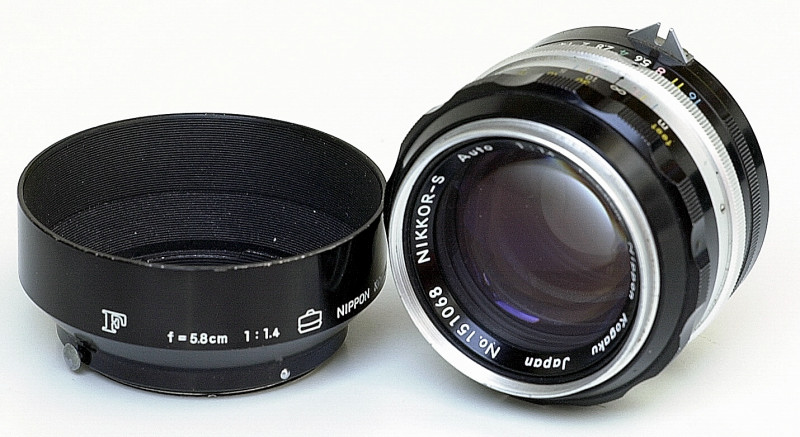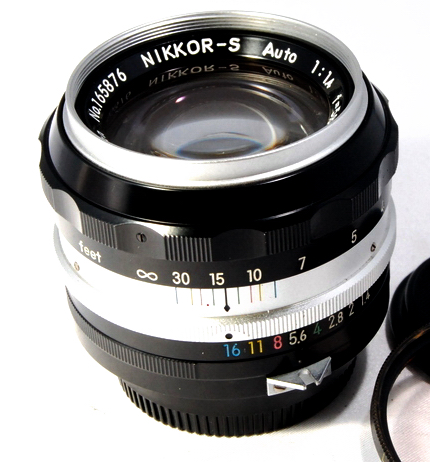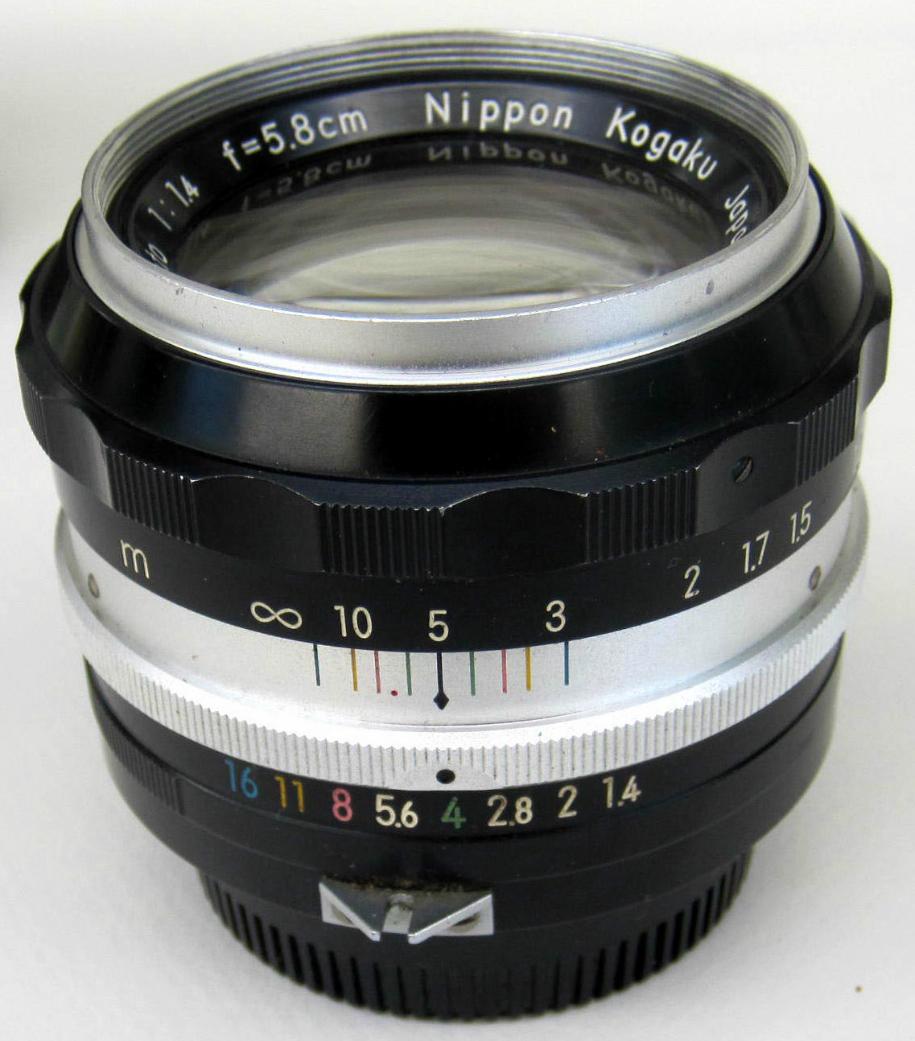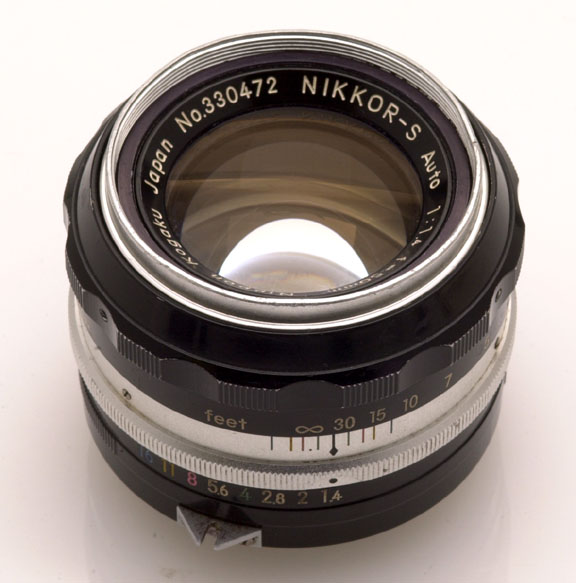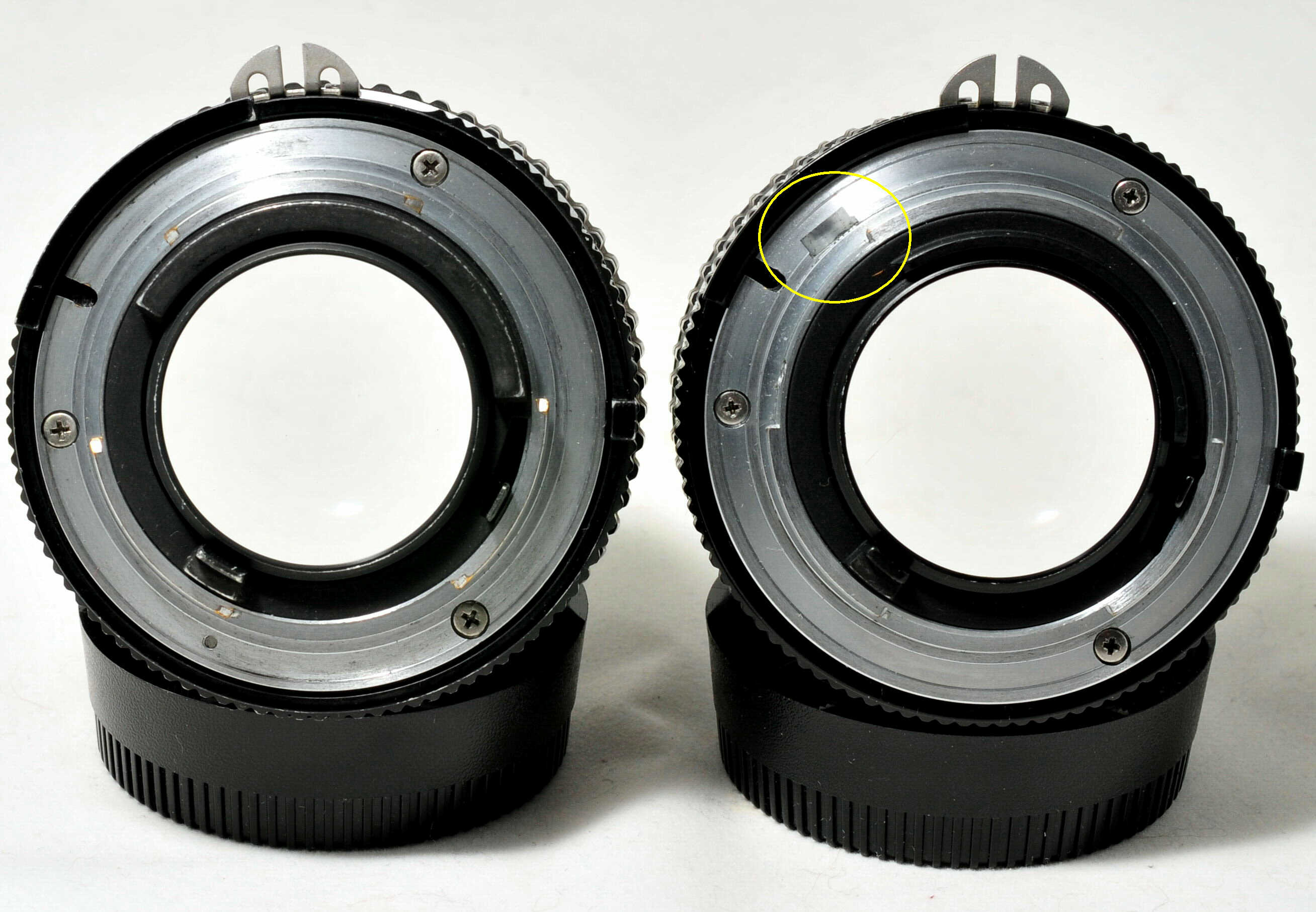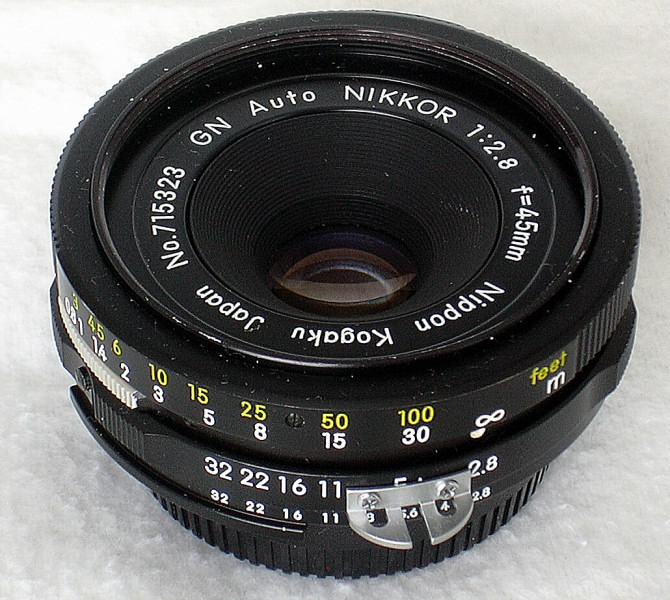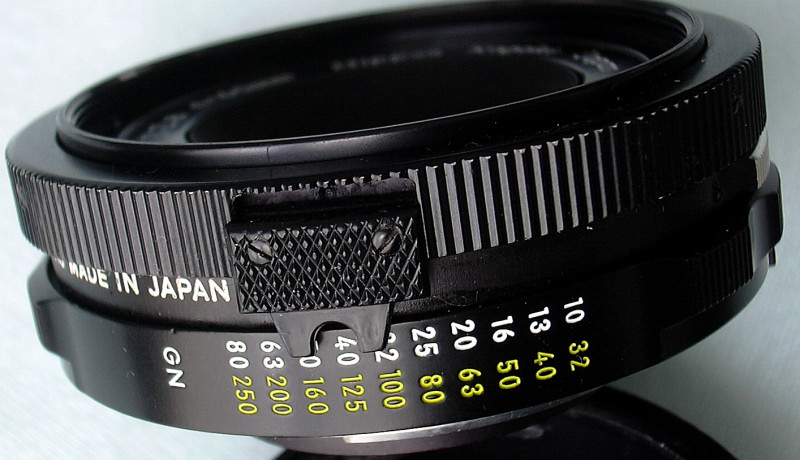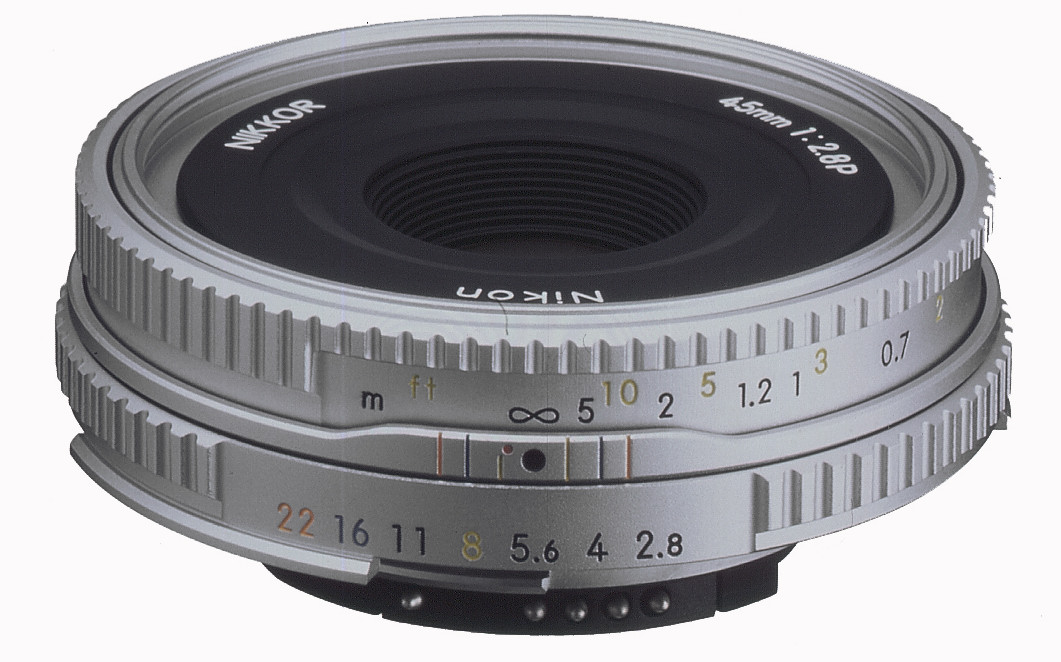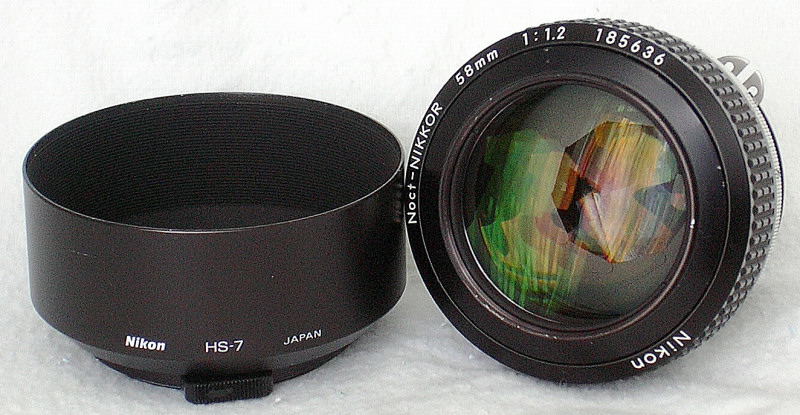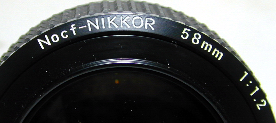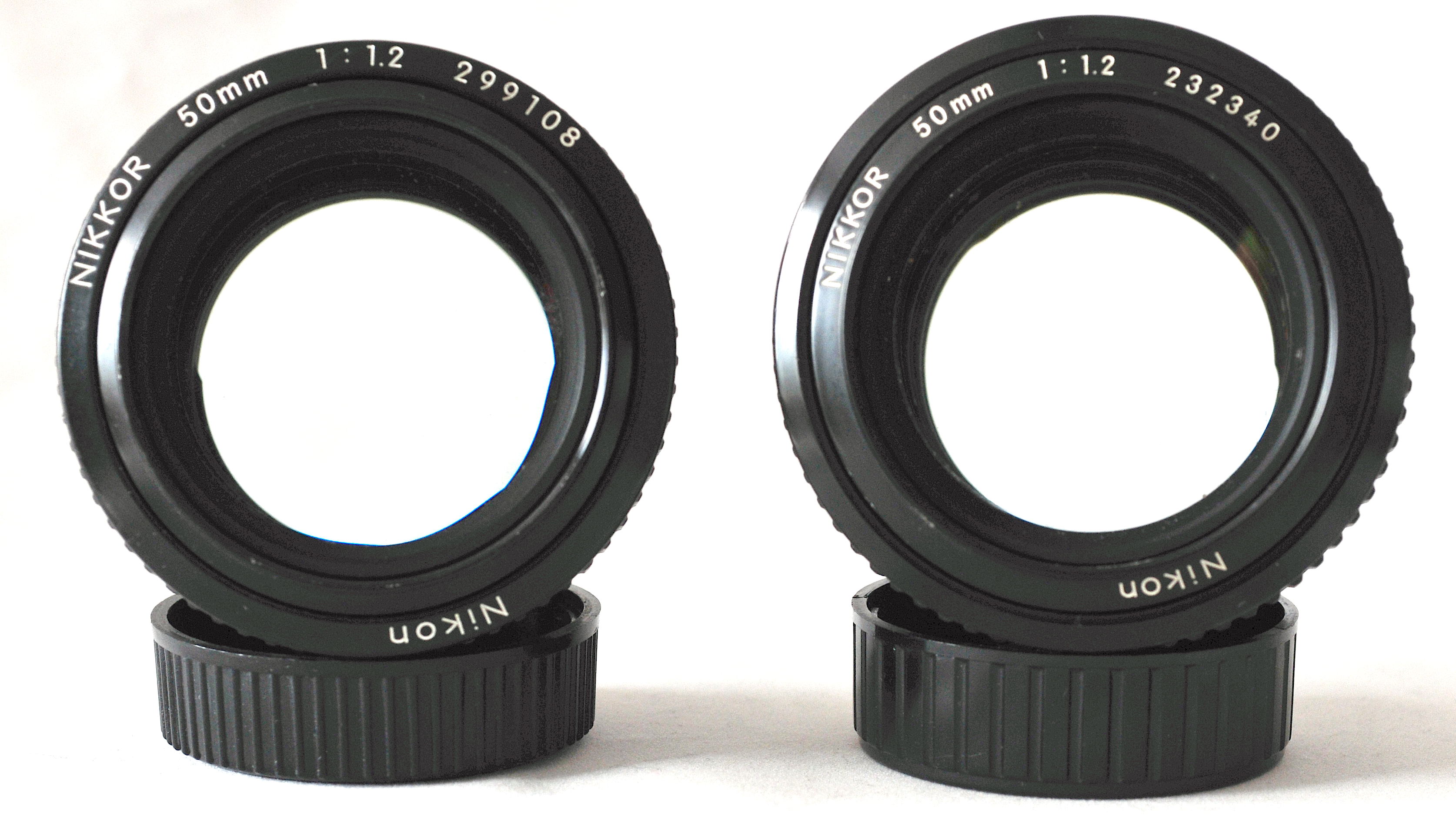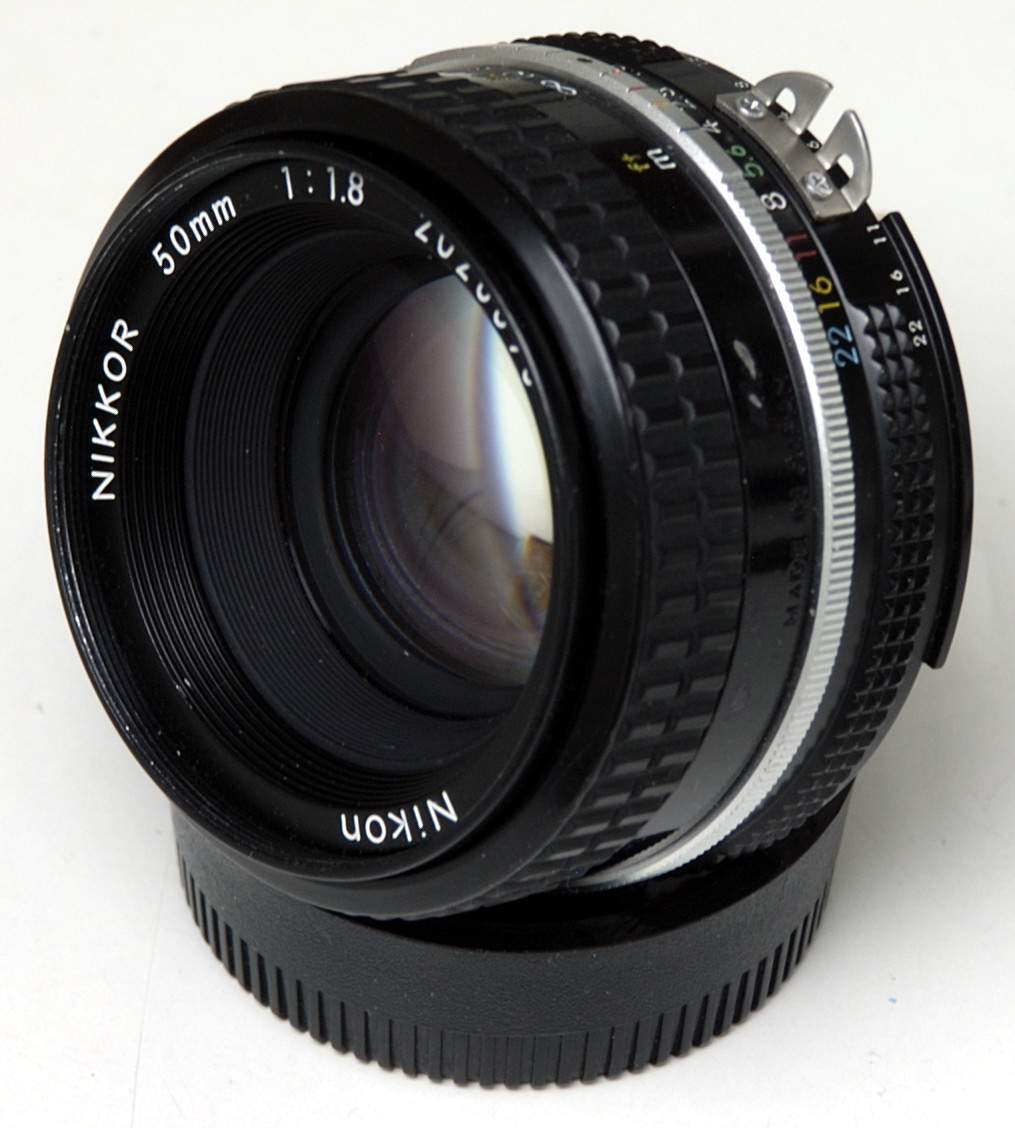Nikkor standard lensesIntroduction
What´s a standard lens?In photography a standard lens is considered to be a lens with a focal length equaling - more or less - the diagonal of the film/frame format. In 35mm. photography the most common film format is 24 x 36 mm. The diagonal of that format is 43.3 mm. Half-frame format (18 x 24 mm.), which is close to the DX-sensor format used in various Nikon digital SLR´s, has a diagonal of 30 mm. So, for SLR´s using 35mm. film a standard lens would be a lens with a fixed focal length of approx. 43 mm. For a digital SLR with a DX-sensor the standard lens should have a fixed focal length of 30 mm. A co-incidence of the size of the before mentioned diagonal is the viewing angle of the standard lens, which ranges between 45 and 55 °. Many lens manufacturers have chosen for the rounded average of 50 mm. as focal length for their standard lens. This has nothing to do with the contention of many publicists that the viewing angle of the human eye would equal the viewing angle of a standard lens. The viewing angle of one human eye comes closer to a lens with a focal length of 18 mm. (= 100°). Nikon produced various standard lenses with focal lengths from 45 - 58 mm. In its early days it was difficult to produce a fast lens - maximum aperture f/1.2 or faster - at a focal length of 50 mm or shorter. Many fast lenses had focal lengths of 55mm and longer. The lens designer has to take into consideration the distance between the rear lens and the plane film and the maximum width of the lens mount. The Nikon F-mount allows a maximum rear lens diameter of 40 mm. In SLR cameras the mirror house is playing an important role as well. The fastest lens Nikon produced for the F-mount cameras has a maximum aperture of f/1.2.
The three fastest standard lenses for Nikon SLR cameras ever made Hereafter all standard lenses will be presented - in chronological order - and reviewed. Since Nikon offers a lot of zoom-Nikkors, standard lenses with a fixed focal length - aka prime lenses - have become less popular. Nevertheless they are very well usable in low-light conditions as most zoom lenses are not faster than f/2.8. All lenses mentioned below can take filters and hoods with a 52 mm. thread. Nikon produced some special lenses with a focal length of 55 mm., so called Micro-Nikkors, which are not listed here. The fixed, thus non-interchangeable standard lenses of the Nikkorex SLR cameras are not listed either.
The three most popular and most produced standard lenses (over 1,5 million of each lens)
Identifications & markingsAll Nikkor lenses are engraved with some data which might be unknown to many people. Nikon named its lenses Nikkor since the early 1930´s. The factory´s name Nippon Kogaku Japan was engraved in the name ring, replaced by a simple Nikon in the 1970´s. As nearly all Nikon products, lenses have a serial number (6 or 7 digits), on older lenses preceded by No. The latter disappeared in the 1970´s as well. On older lenses the word auto indicates that the lens has an automatic diaphragm/aperture; in the 1960´s a modern feature as many lenses had a preset aperture. The very early lenses have the focal length marked in cm., later changed into mm. The maximum aperture was indicated as f=2, later 1:2. This indication refers to the relation/ratio of the focal length of a lens and its maximum aperture. On the aperture ring the possible aperture settings of a lens are indicated: 1 - 1.4 - 2 - 2.8 - 4 - 5.6 - 8 - 11 - 16 - 22. This is an arithmetical series, in which the next lower number equals a twice faster aperture. In other words: a lens (of a certain focal length) with a maximum aperture of f/1.4 is twice as fast as a lens (with identical focal length) with a maximum aperture of f/2. On some lenses a maximum aperture in between two aperture values are given: 1.8 is half way 1.4 -2, as 1.2 is halfway 1 - 1.4. Bear in mind that these indications are based on a maximum aperture of a lens focused at infinity, measured at the lens axis and without taking into account the lost of light due to refraction, internal reflection and other aberrations. When focusing closer both focal length and maximum aperture of any lens may change/decrease. On most lenses at the side of the lens barrel markings like ´lens made in japan´ or ´pat. pend.´ (patent pending) can be found. Finally the letter behind Nikkor indicates the number of elements used in the lens construction. The meaning of these letters can be found here Serial numbers may be used for registration purposes but are also clear indicators - to collectors - of the type or version of a particular lens.
Nikkor-S / Nikkor H / Nikkor H.C 2/5 cm. - 2/50 mm AI
Above on top the AI-version. Under this nice lens the first S-version, the H-version and the H.C-version. At the same moment the first Nikon F was introduced in 1959 this lens was presented. It is an improved version of the rangefinder lens, of which the first design (6 elements in 3 groups) goes back to 1937! The first version of the Nikkor-S 2/5 cm. has 7 elements in 5 groups. In 1963 the Nikkor-H (6 elements in 4 groups) with data in mm. replaces this very nice standard lens. In 1972 the Nikkor-H.C (C = coating) is introduced, which is changed externally in 1974. As with most Nikkors, the new lens design - straight barrel with rubber grip - replaces the scalloped barrel. Production stops around 1978. The lens is still a good alternative for macro photography as it is almost free from aberrations. On a bellows - even in reverse position on a BR-2-ring - it is an excellent macro lens. The very first lenses - #520001 - 584394 - are hard to find, but very interesting to collectors. Especially the so called ´tick-mark´ lenses are sought after. The aperture markings on the lens barrel have extra dashes or marks on the edge. Lenses from #742111 can be converted to AI-mount.
Nikkor-S 1.4/5.8 cm
This rare lens was just three year in production (3/1960 - 3/1963). Probably some 39,000 or less were made (#140051 - 179051). It is a remarkable lens with an acceptable performance, also at full opening. The lens cannot be converted to AI-mount. They all have the triangular fork, no screws in the back flange and a chrome stepped 'nose'. Filter size is 52 mm.
For collectors an interesting lens as the markings on the lens are divers. There are lenses with the distance markings in feet and meters (#14xxxx/15xxxx), or in feet (#14xxxx/16xxxx/17xxxx) or in meters (#15xxxx/17xxxx) (see above pictures)!
Nikkor-S 1.4/50 mm.
early version of the Nikkor-S 1.4/50 mm.
Left AI-version and right the AI/S-version of the Nikkor 1.4/50 mm. This lens was introduced in March 1962. It is more or less based on the Nikkor rangefinder lens that was introduced in December 1950. The first SLR-version (#314101 - 1613735 and 7 elements in 6 groups) was sold until the end of 1974. In 1972 the optical design is changed (7 elements in 5 groups) and a multi-layer coating was added, thus becoming the Nikkor-S.C. In November 1974 the scalloped barrel is replaced by a straight barrel with rubber grip; while in 1976 the former optical design (7 elements in 6 groups) is chosen. The optical design has been changed again in 1977, 1984, 1986 and 1992. In 1986 the first AF-version is put on the market, followed by an AF-D-version, which (in an updated version) is still available. Of this popular standard lens more than 4 million lenses were sold. It is a versatile lens with high quality optics. Full open there is some coma in the corners, which disappears at one stop down. For general photography in low-light circumstances an absolute top lens. If you go for a mechanical version look for the version with serial number starting with 5. It is the best of all.
Left AI-version, right AI/S-version. The latter is a bit (2 mm.) slimmer and internally more complicated. See the typical AI/S notch in the yellow circle.
Nikkor-S 1.2/55 mm. This lens was introduced in 1965 as the fastest standard Nikkor lens of that era. The optical performance of this lens (7 elements in 5 groups) is very good, even at full opening. Due to a strong field curvature at wide openings this lens is not suitable for macro photography. The lens is at its best at apertures from 2 - 5.6 and at distances between 2 and 15 meters. As with many fast lenses, the performance at infinity is a bit disappointing. Serial numbers start at 970111, although a lens with #970103 is pictured in the Nikkormat Handbook. The optical design was altered 2 times, at #220001 and #350011. From #184711 all versions can be converted to AI-mount. The production of this lens stopped in April 1978. Some 172,000 lenses were sold. See special chapter of this legend.
GN-Nikkor 2.8/45 mm. / Nikkor 2.8/45 mm. P
a very dusty GN-Nikkor 2.8/45 mm.
with the pictured sliding tab the guide number of the flash can be set This extraordinary standard lens was introduced in August 1968. GN stands for Guide Number and indicates that this standard lens was specially made for flash supported photography. If the guide number of the flash in use is locked on the lens body, aperture will be adjusted ´automatically´ when focusing. The lens is designed after an old - over one hundred years! - but very solid optical scheme: Tessar = improved triplet = 4 elements in 3 groups. First serial number is 710101, production stopped in March 1977. Less than 40,000 lenses were made, of which all can be converted to AI-mount. Nikon surprised photographers in February 2001 with a successor - Nikkor-P 2.8/45mm. - of this improved triplet design. This lens was introduced together with the Nikon FM3a. A very thin but razor sharp lens with electronic contacts and thus usable on all modern film and digital cameras. Even the lens data are visible in the exif-data in Nikon View etc. Both lenses have a rather strange but highly effective hood. #760001+ black version of the Nikkor-P 2.8/45 mm. (above) and white version (below)
Noct-Nikkor 1.2/58 mm.
This fast lens (7 elements in 6 groups), introduced in February 1977, is the most expensive and most mysterious standard lens of all Nikkors. It is also the first Nikkor with an aspheric front lens, grounded by hand! In most Nikon brochures and price lists this lens can be found in chapter ´special lenses´. Due to the use of an aspheric front lens this lens can be used at full aperture. Aberrations like coma and flair are highly corrected. Even the depth of field (DOF) wide open is acceptable. Two versions in low quantity were made. The rare AI-version (#172011+) and in 1982 the AIS-version (#185001+) were produced until 1999. AI-version some 2,000; the AIS-version some 8,000. The latter version has 9 diaphragm blades (in stead of 7), giving unsharp areas a nicer bouquet (bokeh). This lens is made for low light conditions; therefore it can be used at apertures of 1.2 - 5.6 only. Images made at smaller apertures and close-ups may be disappointing. Using this lens on digital reflex cameras may give problems as light may be reflected on the large rear lens resulting in an underexposed image (automatic exposure program will choose higher shutter speed). On the second hand market still high-priced (out of all proportions to the real value).
Attention to collectors! Lenses with #192801 - #193200 may have an error in the engraving on the name ring: Nocf-NIKKOR !! In fact a t upside down.
Nikkor 1.2/50 mm. This lens, introduced in July 1978, can be seen as the successor of the above mentioned 1.2/55 mm. This lens is a far better performer than the old ´dog´. Its performance - especially that last versions produced after 1994 - comes close to that of the Noct-Nikkor. It´s very well possible to use this lens full open. There are two optically identical models: the AI- and (September 1981) AIS-version. #177051+(AI) & #250001+(AIS).
Easy recognizable: engravings on outer ring = AI/S version (left) and on inner ring = AI-version (right)
Nikkor 1.8/50 mm.
Nikkor-AI 1.8/50 mm. This underestimated lens was put on the market in January 1978 as successor of the Nikkor 2/50 mm. It is a highly corrected razor sharp lens, still available as AF-D- and AF-G-version. The first version is an AI-version (see above), followed by an AIS-version in March 1980. The special version for the Nikon EM camera, the E-Series 1.8/50 mm., affected this lens somehow as publicists stated the lens wasn´t (fully) coated. Nikon always claimed that this version had a Nikon Integrated Coating. In 1986 the first AF-version was introduced. In 2002 Nikon surprised Nikon photographers with a very nice AF-Nikkor 1.8/50 mm.-D-version, which is still very popular. A bigger surprise was the introduction in April 2011 of a G-version featuring an aspherical element! All versions are excellent lenses for general photography as well as for macro-photography.
|
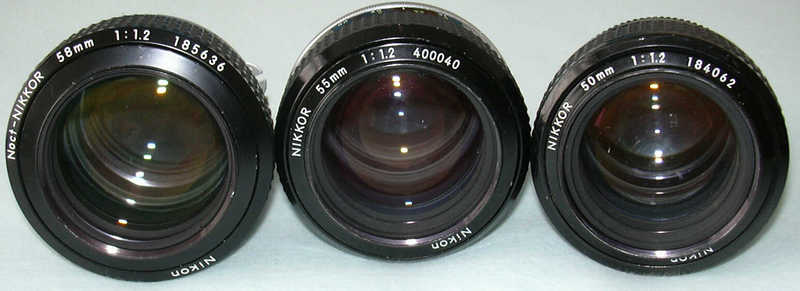
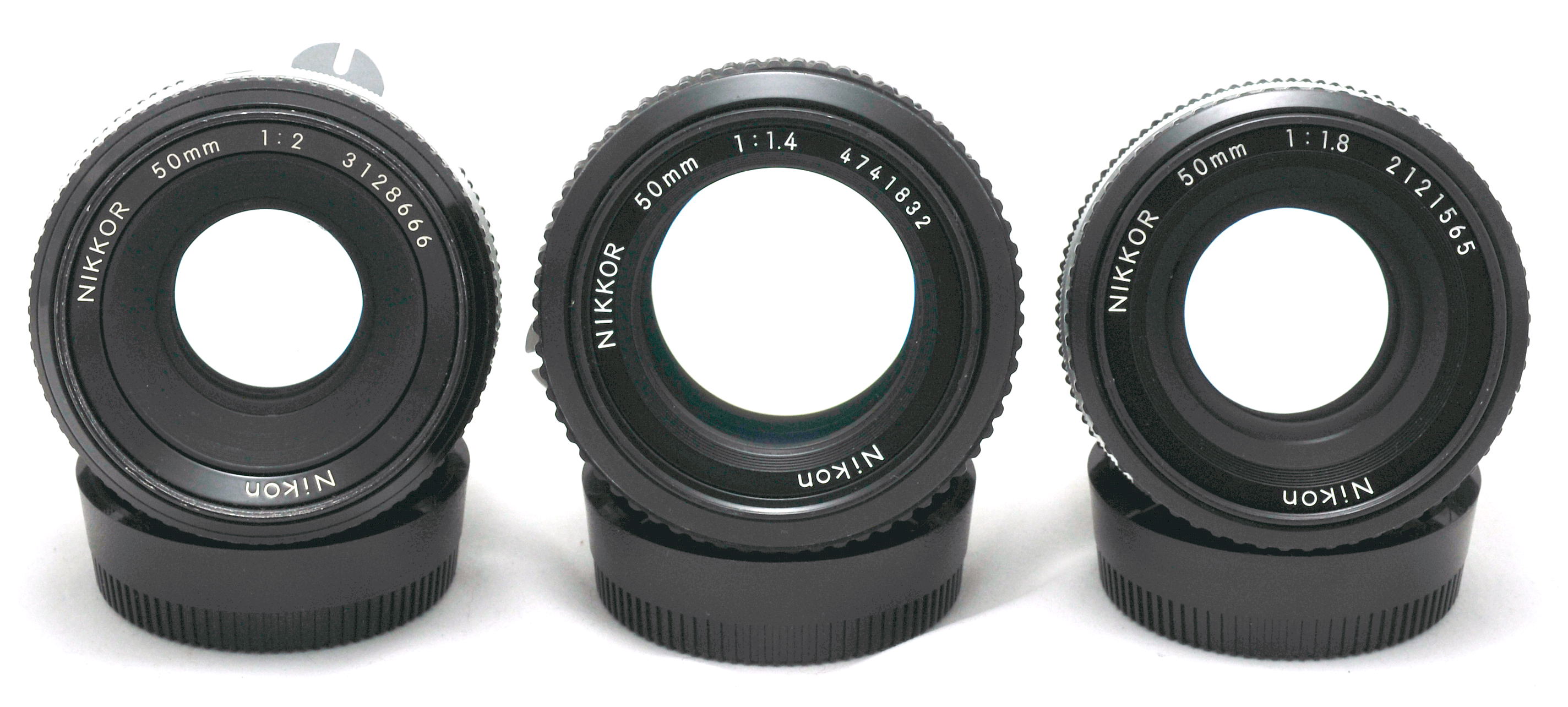
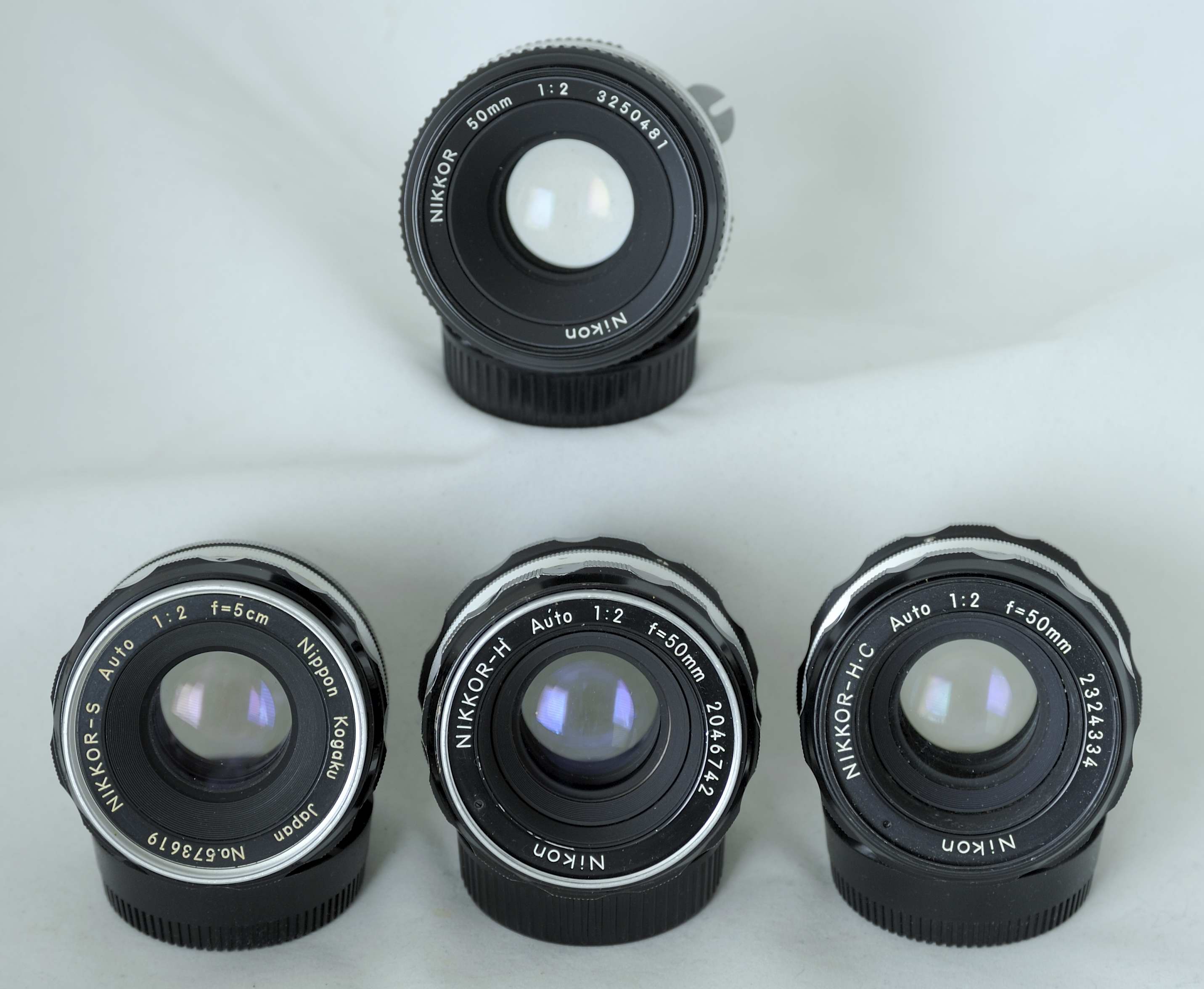 .
.